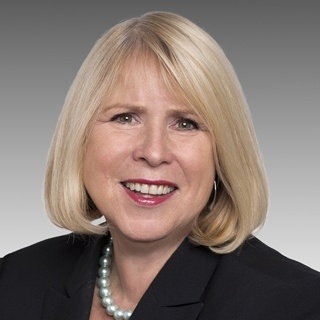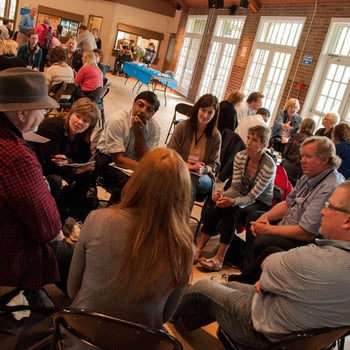Summer Edition, 2016
Getting Beyond Better
BY: MARK CABAJ
What can we learn from nearly a hundred inspiring stories – saving rain forests in the Amazon, transforming education in Latin America,  reforming public health in middle Africa, and reducing poverty in Bangladesh – about how to create transformative change?
reforming public health in middle Africa, and reducing poverty in Bangladesh – about how to create transformative change?
This is the question that Roger Martin, one of Canada’s best known business school leaders and management consultants, and Sally Osberg, President and CEO of the Skoll Foundation, which champions social change efforts around the globe, answer in their book, Getting Beyond Better: How Social Entrepreneurship Works. They also uncover a lot about the frequently referred to, but poorly understood, craft of social entrepreneurship. Here are three of their biggest insights.
First, the authors argue that transformative change requires would-be change makers to disrupt the “stable but inherently unjust equilibrium that causes the exclusion, marginalization, or suffering of a segment of humanity.” Disruption, they go further to define as, “a necessary condition in creating a new equilibrium in the world that alleviates suffering, unleashes new potential and addresses fundamental challenges.” This statement challenges all those who secretly hope we can get transformative change through incremental, non-messy, improvements to the status quo.
Second, Martin and Osberg place social entrepreneurship within the wider field of actors working for a better world. Specifically, they identify three distinct, complementary and important types of change makers:
- Social Service Providers - who take a direct action to address tough issues through programs and services, but often leave the systems in which these issues are embedded in place while addressing its negative effects: e.g., Mother Theresa’s work with those living in extreme poverty in urban Calcutta, which brought immediate relief to thousands and inspiration to millions;
- Social Advocates - who push for legislative policy and regulatory change that transforms the systems that underlie complex marginalization, yet do so by encouraging others to act: e.g., Martin Luther King’s leadership in the civil right movements, including changing laws that excluded African Americans from full political and economic participation; and,
- Social Entrepreneurs - who seek direct action on challenges and concurrently seek to transform the systems in which they are embedded: e.g., Mohammed Yunus, and his work on creating the peer lending model, which has opened up micro-credit to millions of the “poorest of the poor” in the world and created a whole new paradigm of banking.
The authors’ third big finding is that social entrepreneurs typically unfold their work through four key phases. These include:
- Understanding the World – a process of gathering deeper insight into the systemic drivers that underlie complex issues, one that involves a combination of experimentation, observation and seeing the world through the eyes of others;
- Envisioning a New Future – establishing an ambitious vision or picture of the future, either for a specific group of people or challenge, or the world at large;
- Building a Model for Change – developing, testing and refining a new ‘system model’ – even if it’s for a small part of the larger system; and,
- Scaling the Solution – finding ways to scale the model beyond the simple (but expensive) re-application of the same level of investment that went into the original innovation.
Martin and Osberg identify a variety of behaviours and patterns of successful social entrepreneurship in their description of each of these phases. They found that social entrepreneurs wrestle with a series of paradoxes, such as the tension between experimentation and commitment, where social entrepreneurs are deeply committed to making an idea work, but very open to questioning their assumptions about what they think will work and adjusting their innovations when they get new information. Similarly, they have uncovered different ‘mechanisms for change’ – e.g., new measurements, standards, methods – underlying new models for change. These insights not only shed light on the craft of social entrepreneurship, they are practical.
There are plenty of excellent books, papers and tools on social entrepreneurship: a search on google produces 4 ½ million results in less than a second. Yet Getting Beyond Better stands out among the bunch. Why? Because its authors have skillfully distilled key ideas, phases and practices of social entrepreneurship without going so far as to pretend that these can be summed up neatly in a collection of recipe-like practices. It is very difficult to find this balance, but Martin and Osberg have succeeded in spades.
Getting Beyond Better is not the definitive work on social entrepreneurship - the field is too complex to capture it all even in as impressive a book as this - but it is one of the best of a very large bunch. If you count yourself amongst the growing legions of people working to build a world that is beyond better, and treat your work as a craft that requires us to stay abreast of leading edge thinking, then this book is an essential part of your journey.
Learn More:
- Join Roger Martin at Tamarack’s Community Change Institute, Toronto, Ontario, September 26-30th, 2016
- Buy a copy of Getting Beyond Better
- Register for our upcoming Community Change Institute webinars
- Learn more about Roger Martin and his work via his website
- Watch this 1 minute YouTube clip or visit their website to learn more about the Skoll Foundation
Share this article:
Social Innovation: Lessons for Communities
BY: SYLVIA CHEUY
“Disturbers are never popular – nobody ever really loved the alarm clock in action – no matter how grateful they may have been afterwards for its kind service.” - Nellie McClung
Those of us working in communities recognize the need for greater innovation and experimentation if we want to accelerate our ability to advance positive 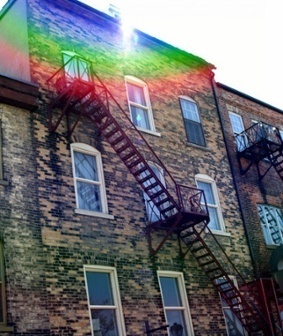 change in neighbourhoods, municipalities and regions. Whether the focus of our work is: citizen engagement, belonging, community safety, poverty-reduction, housing, or community economic development, there is a growing recognition that wiser and bolder approaches are needed to effectively meet the complex challenges before us. So, where do we begin? The robust field of social innovation offers important insights, lessons, patterns and practices to consider.
change in neighbourhoods, municipalities and regions. Whether the focus of our work is: citizen engagement, belonging, community safety, poverty-reduction, housing, or community economic development, there is a growing recognition that wiser and bolder approaches are needed to effectively meet the complex challenges before us. So, where do we begin? The robust field of social innovation offers important insights, lessons, patterns and practices to consider.
ABSI Connect Fellows spent seven months, exploring the field of social innovation in Alberta and the findings of their in-depth exploration are contained in their report, The Future of Social Innovation Alberta 2016. They describe social innovation less as an end-goal or clear formula and more like an ecosystem, or set of, “…people, practices, policies, resources relationships and capacities that interweave together to support social innovation in Alberta.” Their learnings contribute to a growing body of knowledge about the field of social innovation.
A review of the social innovation field offers useful insights for those eager to enhance the impact of their community innovation efforts. Four of these insights are highlighted below.
Insight #1 Consider Innovation on a Continuum
It is useful to think about innovation as unfolding along a continuum, towards an agreed upon end goal. Thinking this way helps to avoid the temptation of choosing one possible idea over another, and instead encourages us to consider the relationship between ideas. In her blog, Nesting Social Innovation, Cheryl Rose, a Senior Fellow with the J.W. McConnell Family Foundation, identifies four different but uniquely powerful elements of change-making:
- Intention – The point when there is AWARENESS that a problem exists
- Involvement – The point when SOMETHING IS DONE about the problem
- Invention – The point when NEW WAYS of addressing the problem are found (e.g. faster, stronger, better)
- Innovation – The point when ROOT CAUSES of the problem are addressed (e.g. changing rules & relationships)
While each of these elements of change-making can stand alone, their full impact is revealed when they are “nested” together. Using the analogy of babushka dolls, Rose observes, "real lasting innovation at a systems level cannot happen without enough creative invention to demonstrate and prepare new possibilities. This rarely happens without significant involvement to gain deep understanding in the issue area, which itself will never occur without sparking individuals’ intention, and their desire to be part of making change happen. When this interconnectedness is present, the energy of a whole field works for impact – and that can make all the difference.”
Insight #2 Emphasize Adaptive Strategies Over Comprehensive Plans
An innovator’s response to problem-solving is less focused on planning and more on process. Interviews conducted by the ABSI Fellows found that, “many successful innovators firmly stated that their key to making progress on complex problems was their ability to be nimble with regard to planning and program development.” So, while there is growing awareness of the limitations of 5-year strategic plans in today’s rapidly-changing world, there is a need to build capacity for adaptive planning with staff and boards in community agencies. Organizations like InWithForward and Winnipeg Boldness provide powerful examples of adaptive problem-solving in action at the community level.
Insight #3 Design With Not For
The design of promising innovations to vexing community problems begins by shifting the relationship between those experiencing the problem and those who see it as their role to fix it. Investing time to build an evidence-informed view of the system that reflects a diversity of perspectives ensures that the issue – and not the proposed intervention – remains at the centre of thinking and action. This kind of cross-sectoral work often requires working across administrative silos and a willingness and openess to engaging government and unusual partners to join in reimagining what is needed and how best to do it.
Insight #4 Recognize and Cultivate the Skills of "Institutional Entrepreneurs"
Renown researcher and social change expert, Frances Westley has long studied the dynamics of systems change which are at the heart of social and community innovation. Her paper, A Theory of Transformative Agency in Linked Social-Ecological Systems explores the role of change makers (individuals and groups) in influencing the transformation of complex systems. Westley calls these individuals and groups “institutional entrepreneurs” and she has identified nine skills that these change agents draw upon as they act as catalysts in the transformation of complex systems. The nine skills of "institutional entrepreneurs" are:
- Facilitating Knowledge Building & Utilization – This skill is demonstrated by the ability to generate and integrate a diversity of ideas, viewpoints and solutions
- Vision Building – This skill includes the ability to synthesize a compelling, inspiring vision that unifies individual visions and attracts support
- Developing Social Networks – This skill encompasses the building of mult-sector coalitions as well as the capacity to bridge between different actors and stakeholders within a variety of organizations and/or hierarchies
- Building Trust, Legitimacy and Social Capital – This skill includes the ability to recognize the contributions of formal authorities and bridge them with the emerging consensus of a diverse group of stakeholders
- Facilitating the Development of Innovations – This skill emphasizes the ability to foster knowledge-building by linking different types of thinking as well as the ability to identify and introduce new processes and products.
- Mobilizing for Change – This skill includes linking innovative ideas to existing funding opportunities as well as the ability to leverage existing and new resources and funding to support promising innovations
- Recognizing Windows of Opportunity – This skill includes the ability to sense, and capitalize on, the dynamics of the system one is operating in to identify and capitalize on emerging opportunities.
- Identifying Opportunities for “Small Wins” – This skill highlights the ability to envision small, achievable projects, that offer promise in demonstrating the possibilities of systems change and innovation.
- Facilitating Conflict Resolution – Conflict is often a natural and normal by-product when diverse perspectives attempt to work together on a common issue. This skill recognizes the ability to effectively surface and resolve tension when it emerges and is critical to the long-term effectiveness of any system change effort
Drawing upon the insights, practices and learnings of the field of social innovation offers a useful lens to inspire and invite us to think critically about ehancing our community innovation effforts. However, discernment -- and trust in one's own knowledge of community work -- is also required to ensure that ideas and approaches do not trump the unique context of your community, and that the needs of community remain at the centre of your thinking and action.
Learn More:
- Join Frances Westley at Tamarack’s Community Change Institute, Toronto, Ontario, September 26th - 30th, 2016
- Read A Theory of Transformative Agency in Linked Social-Ecological Systems by Frances Westley
- Download the Report of the ABSI Fellows, The Future of Social Innovation Alberta 2016 Report and Summary
- Read Cheryl Rose’s blog, Nesting Social Innovation for more on the Social Innovation Continnum
Share this article:
Tamarack 2015: A Year in Review
BY: RACHEL GAINER
Tamarack Institute was founded in 2002 and for the past 14 years we have had one simple goal. Our community of volunteers, learners and staff are dedicated to making the work of community change easier and more effective. We believe in systems change and our work assumes that we can change whole systems, for the better. We look for evidence of change in our communities – like improvements to individual or family outcomes, increased capacity within communities to address social issues, or new policies and programs to improve peoples’ lives.
Our 2015 Annual Report has been a humble reminder of all that we have accomplished, in collaboration with our members over the past year. We embraced the possible, and we are so thankful to be able to do so with our growing learning community and supportive partners. Here are just some of the ways the Tamarack Institute is evolving and creating a connected force for community change.
A Growing Learning Community
We started 2015 with just over 15,000 members in our learning community. Halfway through 2016, we are 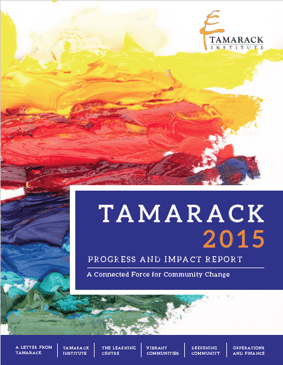 proud to report that this has increased to over 21,000. These members have access to our three monthly e-newsletters -- Engage!, Cities Connect and Seekers Journal, free monthly webinars, useful tools and resources to download. We are smarter together because of the way we engage with one another, learn about what works and what does not, and we change together as a result of the insights shared by this powerful and growing learning community.
proud to report that this has increased to over 21,000. These members have access to our three monthly e-newsletters -- Engage!, Cities Connect and Seekers Journal, free monthly webinars, useful tools and resources to download. We are smarter together because of the way we engage with one another, learn about what works and what does not, and we change together as a result of the insights shared by this powerful and growing learning community.
Idea Areas
At Tamarack, we follow five Idea Areas:
- Collective Impact
- Community Engagement
- Collaborative Leadership
- Community Development
- Evaluating Community Impact
We turn theory into action by connecting people in learning together across these five Idea Areas. Last year, we hosted 19 webinars, 10 one-day workshops, and 8 multi-day workshops designed to facilitate the latest thinking, transfer knowledge and help participants turn ideas into action.
Vibrant Communities
Speaking of action, collaborative leaders from business, government, the voluntary sector, and citizens with lived experience of poverty have been working together to effectively reduce poverty for more than 202,931 Canadians with the help of Vibrant Communities. Last year, we worked with 25 cities to develop their own poverty reduction strategies and over 400 people participated in the first ever National Poverty Reduction Summit in Ottawa. Every day we are closer to our goal of reducing poverty for 1 million Canadians.
Deepening Community
Meaningful projects are being implemented as part of Tamarack’s Deepening Community Practice Area which explores programs, policies and practices to strengthen communities and neighbourhoods, cultivate citizen leadership, and enhance social capital. Each year we partner with up to five communities on action learning initiatives that: connect neighbours to one another; identify skills and interests they can contribute; and, build consensus around specific projects that can be implemented together that positively contribute to enhance the places where we live.
The Tamarack Team
Over the years, our team at Tamarack Institute has also grown and evolved. Our team brings together amazing skills, talent and experience from across Canada and we represent a variety of sectors and ages as well. We are sustainable. Our staff work where they live and most walk to work. Our offices are shared or home-based which saves energy. To us, growth means building stronger relationships with each other, our credible and generous partners, government and foundations, as well as diversifying our structure.
Our collective belief in the possible is the force that drives us to work with others, to innovative, release and accept with a continuos focus on making things better for each other and our communities. Read our 2015 Annual Report to learn more about Tamarack Institute’s journey and what we see as lying ahead in our future.
Learn More:
- Download Tamarack’s 2015 Annual Report
- Learn more about the Tamarack Team
- Visit Tamarack’s three online learning sites: Vibrant Communities, Deepening Community and Tamarack CCI to find resources to enhance your own work
Share this article:
ABCD in Canada
BY: AL ETMANSKI
“Ain’t it how it seems to go. You don’t know what you’ve got till it’s gone”
- Joni Mitchell
There is nothing extraordinary about Asset Based Community Development (ABCD). It’s as ordinary as looking out for your family, your neighbours, your environment. Or extending a hand to people who are down on their luck, struggling or vulnerable. Or banding together with others to fix a common challenge.
People have been doing Asset Based Community Development pretty well since the beginning of time. Before there were institutions, bureaucracies, service providers and professionals. When they only had each other to depend on.
 When people are left to their own devices they take stock. They figure out the extent of their challenge. The resources they have. The resources they need to find. And then in a flourish of abundance they problem-solve.
When people are left to their own devices they take stock. They figure out the extent of their challenge. The resources they have. The resources they need to find. And then in a flourish of abundance they problem-solve.
Sound familiar?
It should. It’s been happening in Canada for a very long time. The early settlers would not have survived a harsh unforgiving climate and rocky soil without the helping hand of indigenous people. Indigenous people would not have survived the ravages of residential schools and attempts at genocide without relying on each other. And of course as we have seen most recently, the destruction of the Fort McMurray fire was tempered immediately by ordinary citizens doing what they do best, rising to the occasion and taking care of one another.
But these are just the tip of the iceberg. What is happening beneath the surface is in many ways more astounding. Every day, everywhere, just about everyone is involved in taking care of family, friends, neighbours and co-workers as well as the water, birds, rocks, trees and indeed all life. Freely. Voluntarily. Lovingly. It is hard to imagine society functioning without these millions of small acts. Paradoxically when something is so commonplace, no matter how essential, it tends to be taken for granted. To be ignored or dismissed. Even disrespected.
That’s the gift the composers of ABCD, John McKnight and Jody Kretzman, have given us. They present our caring and ingenuity back to us in such an elegant way that we can appreciate its beauty and respect its power.
ABCD codifies the extraordinary achievements of ordinary people especially when they act together. John and Jody didn’t invent it. They observed it. Here are three of their observations that have always struck me:
- Communities become healthier and more resilient when those who are used to contributing step back and start receiving from those who aren’t typically expected to contribute;
- Citizens, acting through voluntary associations, are the richest source of social innovation and are integral to their implementation from start to finish; and,
- Professionals, intentionally or unintentionally, can undermine the capacity of individuals, families, networks and associations to take responsibility for each other and the planet.
Like all magnificent concepts, ABCD ignites the imagination. It is impossible to look at the world in the same way once you see it through the lens of ABCD. It has changed my life in so many ways. For example, it helped Vickie and I anchor PLAN’s work exclusively to the power of neighbourliness.
On the surface ABCD makes you feel better. Applying it to one’s work is another matter. It requires discipline, rigour and a commitment to let go of a lot of what you hold dear. ABCD is not a recipe. It’s a work in progress. Therefore, it continues to learn and grow. For example, it’s still sorting out its relationship with government, professionals and money. Plus, ABCD is playing teeter-totter with powerful societal forces such as the momentum of outmoded approaches, consumerism, the iron rule of the economy, our fascination with technology and our deference to experts.
That’s where you come in. Growing ABCD in Canada is a job for farmers not mechanics.
We know our ‘soil’ contains the right ingredients: kindness, hospitality and ingenuity in the face of adversity. Nurturing the right conditions for it to grow healthy crops is another matter. I can think of no other way to do it than to put on our ABCD glasses and extract ourselves from the needs-maker’s grasp. That means defining our challenges on our terms, taking stock of the treasure trove of resources we already have at our disposal, swallowing our egos and rallying the caring power of all Canadians.
Now, that would be extraordinary wouldn’t it?
Learn More:
- Visit the new ABCD in Canada website hosted by Tamarack
- Discover more about Al Etmanski, community organizer, social entrepreneur, author and lon-standing member of the ABCD network
- Read A River Runs Through John to learn more about John McKnight
- Watch this video of John McKnight at Tamarack’s 2015 NPP Gathering in Hamilton, ON
- Learn more about the power of connected citizens at www.deepeningcommunity.ca
Share this article:
Change is Here: Our Online Learning Has Evolved
BY: MEGAN WANLESS
When Tamarack was founded back in 2002, the use of technology in the non-profit sector was very different. Online communication was far less interactive and responsive, and navigating the world wide web was done almost exclusively at our desks, not on-the-go from our smartphones. Fast forward 14 years, and now Tamarack is an Institute in its adolescence – a little more mature, a little less inexperienced, still fascinated with the possibilities that technology brings to the work we do. What have we been doing all of this time? We have:
- Launched multiple domains to support tamarackcommunity.ca, including vibrantcommunities.ca and deepeningcommunity.ca: two of our most important campaigns with communities of practice trailblazing the path towards poverty reduction and more resilient communities;
- Experimented with online communities, to provide members of our learning communityi with ineractive spaces -- including tamarackcci.ca to engage in important dialogues about working collaboratively. In this space, practitioners from around the globe can meet and share useful resources and experiences;
- Produced more than 100 informative webinars and podcasts featuring inspirational and innovative thought leaders in the field;
- Joined three social media platforms, allowing us to connect and interact in real time with rapidly growing communities of inspiring, grassroots and professional change makers.
What hasn`t changed? Our commitment to community change. From the beginning, our hope has been to create an Institute that would deeply understand community change, and help organizations and citizens work better together for a collective impact. Technology may be complicated, but the challenges communities face everywhere are the most complex - from climate change to economic inequality to disruptive innovation. As we have been exploring since the inaugural Community Engagement: The Next Generation workshop, we see technology not as an answer for community, but rather as a tool that has the ability to make our work more efficient and effective and helps us ask more informed questions.
One question we are constantly asking ourselves is: How can we better support our learners as they face these complex challenges?
Change is at the centre of our work and we have made some major changes ourselves in order to support our learners and make your work easier and more effective. This summer we are proud and excited to unveil our brand new online home! At www.tamarackcommunity.ca, you will find: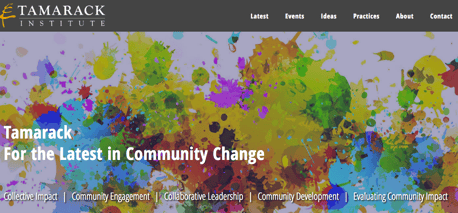
- The Latest - It is our promise to bring you the latest in community change. Explore our Resource Library and Latest sections to read, listen and watch ideas from our learning community and beyond.
- Events - We're hosting the same great events with our learners in mind. Check out our Events section for information about upcoming face-to-face learning events – including this Fall’s Community Change Institute – along with upcoming free webinars to advance your learning and professional development.
- Ideas - Explore the Ideas section for more on Tamarack’s five BIG ideas for making significant community change – Collective Impact, Community Engagement, Collaborative Leadership, Community Development and Evaluating Community Impact.
- Practices | Tamarack’s Practices section profiles our work to turn theory into practice by learning more about our two practice areas: Vibrant Communities: Cities Reducing Poverty and Deepening Community.
- About | The About section is where you can read about our story, our expertise, and how we work. You can also get to know the faces of Tamarack.
We knew our old website needed a facelift and a reimagining of how to bring you the latest tools, resources and thinking for community change. After all, our job is to make your work easier and more effective. But, if you have ever launched a new website, you will know it is no easy feat. Admittedly, we have felt a bit nervous along the way. Change can be exciting yet nerve-wracking at times – what will our Learning Community think of this change? Does our new site do the trick? We'd love your feedback so that we can continue to refine it in order to ensure we are doing everything in our power to support you and the incredible work that you do. Fill out this short survey to let us know your thoughts or use the Tell Me More tab on the bottom right hand side of our homepage.
Learn More:
- Visit our new website at www.tamarackcommunity.ca
- Let us know what you think of our new site and ideas for making it better via our survey
Share this article:
THE POWER OF CARING: PAY ATTENTION TO WHAT FEEDS YOUR SPIRIT
By: Nicole Dawe
Read the Post
CIRCLES OF INFLUENCE
By: Deb Halliday
Read the Post
UPSIDE-DOWN THINKING: A WAY TO FUEL CHANGE
By: Kris Culp
Read the Post
BEYOND YOUR FRONT DOOR IN LETHBRIDGE
By: Jerry Firth
Read the Post
PROFESSIONAL GENEROSITY: WALK THE WALK
By: Elayne Greeley
Read the Post
BOLD ACTION TO END POVERTY IN CANADA
By: Paul Born
Read the Post
Community Change Institute
September 26-30, 2016
Toronto, ON
The inaugural Community Change Institute is designed to be a truly transformational learning experience, bringing you the latest in community change with top speakers, an amazing faculty and over 40 workshops in the areas of:
- Collective Impact
- Collaborative Leadership
- Community Innovation
- Community Engagement
- Evaluating Community Impact
Upside Down Thinking
July 28, 2016 | Calgary, AB
September 12, 2016 | Red Deer, AB
In this one-day workshop participants will learn about Upside Down Thinking - both a mindset and a tool to challenge current practices in our community work and within our organizations.
Join disruptive thinker, Mark Holmgren to learn the fundamentals of this approach, practical tools for using it as both a group participant and facilitator and learn how to apply this thinking to make an impact on our ability to think and make change together.
Webinars
Community Change Institute Webinar Series
July 20 & 27, 2016 | 12:00 - 1:00 p.m. EST
Free Online Learning Series
With the Community Change Institute fast approaching, each 1-hour webinar in this series will focus on a different theme that will be featured at the event. Each webinar will also bring in both faculty from the event, such as Liz Weaver and Paul Born, as well as Keynote speakers, such as Stephen Patrick and Severn Cullis-Suzuki, to provide an introductory conversation around key topic areas such as the art of disruption and collective impact.
The Ontario Student Grant: A Case Study in Collaboration
July 26, 2016 | 12:00 - 1:00 p.m. EST
Free Webinar
This spring, the Government of Ontario embarked on the single largest modernization to the Ontario Student Assistance Program (OSAP) ever, making tuition free for low and moderate-income families, reducing costs for many middle-income families, and turning a complicated grant and loan system into a streamlined system geared to increase accessibility and flexibility for students. Join Deputy Premier and Minister for Advanced Education and Skills Development Deb Matthews to find out how Ontario brought together those inside and outside government to ensure that merit, not money, determines who can access higher education.
Collective Impact Webinar Series
May 9 - September 8, 2016 | 12:00 - 1:00 p.m. EST
Free Online Learning Series
This 9-part capacity building series is jointly supported by Ontario Trillium Foundation and Tamarack Institute and focuses on the key elements of collective impact. Each one-hour session will focus on one of the five phases of collective impact and will review tools that will help guide planning for that phase. At the end of each session a brief description of Ontario Trillium Foundation's Collective Impact Grant will be provided.
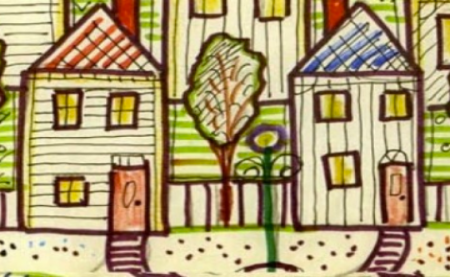

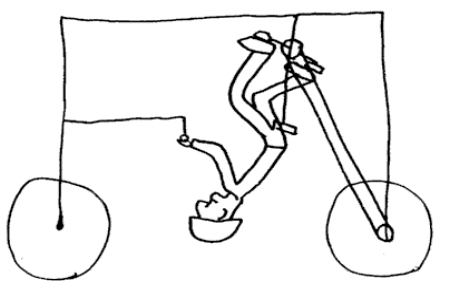

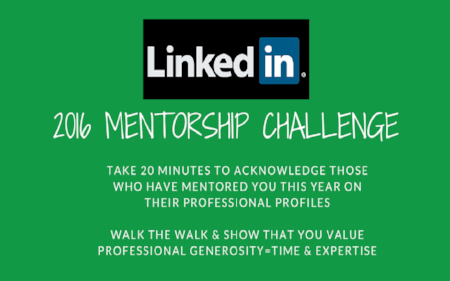
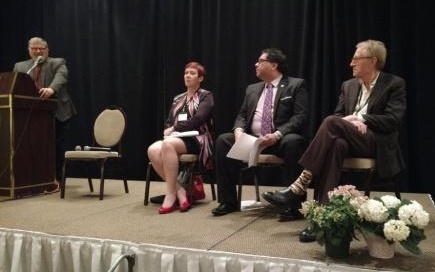
/CCI_Banner_2016_Square.jpg?width=500&name=CCI_Banner_2016_Square.jpg)


